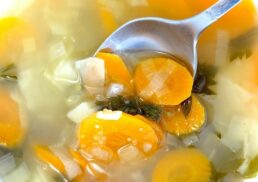Have you ever heard of calamansi fruit? This incredibly versatile citrus fruit native to the Philippines is gaining popularity worldwide for its unique flavor and numerous uses. From traditional Filipino dishes to innovative recipes, calamansi fruit can add a delightful twist to your cooking. Read on to unlock the secrets of this amazing fruit and learn how it can benefit your health, culinary creations, and even home remedies.
Table of Contents
Key Takeaways
Discover the unique flavor profile of calamansi, a hybrid citrus fruit native to Southeast Asia with high levels of vitamin C.
Learn about its history and origin, versatile uses in culinary delights and home remedies for health benefits.
Find tips on growing and harvesting calamansi as well as recipes for traditional Filipino dishes, refreshing drinks & creative culinary creations!
Discovering Calamansi: A Citrus Treasure

Calamansi, also known as Philippine lime or calamondin, is a small citrus fruit native to the Philippines. This tasty citrus fruit is a hybrid of kumquats and mandarin oranges, bearing a unique flavor profile that blends orange, grapefruit, and lime/lemon. Primarily grown in Southeast Asia, calamansi is an essential ingredient in many traditional dishes, adding a bright citrus flavor to both sweet and savory recipes.
The calamansi tree (Citrus microcarpa) thrives in the warm, tropical climate of the Philippines, where it bears fruit in abundance. The fruit’s skin shifts from green to a vivid orange when mature, and its flavor is a distinctive combination of sour and slightly sweet notes. With its high vitamin C content, calamansi is not only a delicious fruit but also a valuable source of nutrients for your body.
History and Origin
The calamansi fruit is believed to have originated from the Himalayan mountains. Over time, it spread throughout Southeast Asia, where it is now cultivated and used in various cuisines, such as in:
Indonesia
Malaysia
Thailand
India
Its hybrid nature, resulting from the cross-pollination of kumquats and mandarin oranges, gives calamansi a unique flavor that sets it apart from other citrus fruits, including the mandarin orange.
Calamansi is known for its high content of:
Vitamin C
Vitamin A
Potassium
Calcium
making it a nutritious addition to your diet. In the Philippines, it is commonly referred to as “calamansi” or “calamondin”, and its popularity in Filipino cuisine has led to its use in a wide variety of traditional dishes. From savory soups to zesty marinades, calamansi adds a tangy, citrusy flavor that enhances any dish it’s added to.
Unique Characteristics
Calamansi is a small, round citrus fruit with a thin, bright yellow-orange skin. Its unique flavor profile combines sourness with a subtle sweetness, making it a versatile ingredient in various cuisines. The fruit’s versatility is due to its ability to add brightness to both sweet and savory dishes, making it a popular choice for chefs and home cooks alike.
When selecting calamansi, look for fruits that are:
Beginning to turn from pale green to yellow, as fully orange fruits are overripe, and green fruits are underripe
The skin should be smooth and firm to the touch
The fruit should be stored at room temperature for 3-5 days, or up to two weeks in the refrigerator.
With its unique flavor and numerous uses, fresh calamansi is a delightful addition to any kitchen.
The Versatile Uses of Calamansi
Calamansi offers a wide range of culinary and therapeutic uses. Its tangy flavor profile makes it a sought-after ingredient in Filipino cuisine, where it is used in:
marinades
dressings
desserts
cocktails
Additionally, it is believed that calamansi can help treat coughs and colds due to its high vitamin C content.
Let’s dive deeper into the many ways calamansi can be used in the kitchen and beyond.
Culinary Delights
In Filipino cuisine, calamansi is a pivotal component in numerous dipping sauces, including those used as a dipping sauce for dishes like sinigang, a sour soup. Its distinctive flavor also shines in various Asian dishes, where it can be used as a marinade for meats, a dressing for salads, or even as a tart filling for desserts.
Furthermore, calamansi is a popular ingredient in beverages, both alcoholic and non-alcoholic. Some ways to enjoy calamansi in drinks include:
Calamansi juice, often sweetened with sugar or honey, is a refreshing drink commonly enjoyed in the Philippines.
In Malaysia and Indonesia, calamansi is used in cocktails such as mojitos and margaritas for a tangy twist.
Its unique flavor also makes it an excellent addition to iced teas and lemonades.
Calamansi, with its adaptable nature and vibrant taste, has sparked the creativity of both professional chefs and home cooking enthusiasts. Whether it’s classic Filipino cuisine or innovative fusion dishes, calamansi lends a unique citrus note that uplifts every culinary concoction.
Home Remedies and Health Benefits
Besides its culinary applications, calamansi is also known for its health benefits. Some of the health benefits of calamansi include:
Rich in vitamin C, it can help support the immune system
Possesses anti-bacterial properties
Used as a remedy for upset stomachs, with some suggesting to drink a glass of calamansi juice or add calamansi to a cup of warm water for relief.
Calamansi, with its enticing flavor and array of health benefits, is a commendable dietary addition. Its rich vitamin and mineral content coupled with its therapeutic properties provide natural alleviation for ailments like coughs, colds, and indigestion.
Growing and Harvesting Calamansi
If you’re a fan of calamansi, why not try growing your own calamansi tree?
Here, we’ll delve into the optimal climate for calamansi trees and offer guidance for their care and maintenance, leading to a rich harvest.
Climate Conditions
Calamansi trees thrive in warm, humid climates with a temperature range of 75-85°F or 23-30°C. However, if you live in a cooler climate, you can still grow calamansi trees in pots by selecting dwarf varieties and maintaining the plant in a light, warm, and humid environment. This way, you can enjoy the delicious fruit even if you don’t reside in a tropical area.
Bees and other pollinators are attracted to calamansi flowers, helping them produce fruit. By providing the right climate conditions and ensuring adequate pollination, you can successfully grow your own calamansi tree and enjoy the fruits of your labor.
Tree Care and Maintenance
Proper care and maintenance of your calamansi tree are essential for healthy growth and fruit production. Here are some tips to follow:
Plant your tree in well-drained soil.
Water it regularly, making sure the soil is moist but not waterlogged.
Make sure your tree receives at least 6 hours of direct sunlight per day.
Fertilize your tree every 2-3 months with a balanced citrus fertilizer.
Prune your tree during late winter or early spring to maintain its shape and remove dead or diseased branches.
By following these tips, you can ensure that your calamansi tree thrives and produces abundant fruit.
Fertilization is also crucial for calamansi trees. Use a balanced citrus fertilizer, applying it in early spring and once more in late summer to provide essential nutrients for growth. With proper care and maintenance, your calamansi tree will flourish and bear fruit for you to enjoy.
Harvesting Tips
To ensure peak calamansi fruit quality and flavor, harvesting should be done with care. Using pruners or kitchen scissors, cut the fruit off the tree. Cut just above the stem attachment, leaving a small piece of stem attached to the harvested fruit. This helps prevent damage to the fruit and allows for longer storage.
Calamansi fruit begins to blush orange in November and is fully orange-ripe by mid-January, remaining on the tree until March. Harvest your calamansi at the right time to ensure optimal flavor and quality, allowing you to enjoy the fruit in all its delicious variations.
Shopping for Calamansi: Where and How
For those unable to cultivate their own calamansi trees or in immediate need of the fruit, it’s vital to understand where to procure calamansi and how to choose and preserve it for optimal quality and taste.
In the following, we’ll share some pointers on locating calamansi, choosing the finest fruits, and maintaining ideal storage conditions.
Finding Calamansi
Calamansi can be found at most Filipino or Asian supermarkets, as well as online and at local markets. However, if you’re interested in growing your own calamansi tree, you can purchase seeds online or at local nurseries and start cultivating your own fruit.
The best way to enjoy calamansi is to find it in its freshest form at a local market, where you can select fruits that are firm, bright in color, and have a sweet smell. This ensures that you’re getting the best quality fruit for your recipes and home remedies.
Selecting and Storing
When selecting calamansi, look for fruits that are firm, heavy for their size, and have a bright, glossy skin. To store calamansi, keep it in a cool place, away from direct sunlight. If you plan to store it in the refrigerator, make sure the fruits are completely dry before placing them in a plastic or paper bag and storing them in the refrigerator’s crisper drawer.
To extend the shelf life of your calamansi, you can also freeze the fruit, either whole or in slices. To use frozen fruit slices in recipes or beverages, simply thaw them at room temperature for about 15 minutes before using.
Calamansi in the Kitchen: Recipes and Inspiration
Equipped with knowledge about calamansi, its applications, and storage tips, it’s time to dive into some tasty recipes. Let these ideas spark your creativity in crafting your own culinary delights with this special citrus fruit.
Traditional Filipino Dishes
Calamansi plays a starring role in many traditional Filipino dishes, such as Bistek Tagalog, a savory beef-and-onion dish, and chicken adobo, a flavorful combination of soy sauce, vinegar, and spices. Its tangy flavor enhances the taste of these dishes, making them a staple in Filipino cuisine.
Other traditional Filipino dishes that feature calamansi include:
Calamansi Chicken
Calamansi Fish Fillets
Calamansi and Patis-Glazed Lechon Kawali
Calamansi Walnut Bars
These dishes showcase the versatility of calamansi and its ability to add a unique flavor to a wide range of recipes.
Refreshing Drinks
Aside from its use in traditional dishes, calamansi also makes an excellent ingredient in refreshing beverages. The Calamansi Rickey Cocktail is a simple drink that highlights the invigorating flavor of calamansi, while the Calamansi Cold Brew combines the fruity citrus notes with the rich taste of coffee for a unique twist on a classic drink. Add some ice cubes to either of these beverages to enhance their refreshing qualities.
Other popular calamansi beverages include Calamansi Juice, often sweetened with sugar or honey, and Calamansi Iced Tea, a delightful combination of tea, calamansi, and sweeteners like honey or agave syrup. These drinks showcase the versatility of calamansi and its ability to create a wide range of delicious and refreshing beverages.
Learn more, visit How to Make Calamansi Juice.
Creative Culinary Creations
Calamansi’s unique flavor inspires chefs and home cooks alike to create a variety of dishes and drinks. From fusion dishes that combine different culinary traditions to inventive salad dressings and desserts, calamansi adds a distinctive citrusy touch that elevates any culinary creation.
Some examples of creative calamansi recipes include Calamansi Muffins, Calamansi Cheesecake, and Calamansi Sorbet. These dishes showcase the versatility of calamansi and provide inspiration for your own culinary experiments.
So why not try incorporating calamansi into your next recipe and experience the delightful flavor it has to offer?
Calamansi Alternatives: When You Can’t Find the Real Thing
If you can’t find calamansi or simply want to try other citrus fruits with similar flavors, there are several alternatives available.
In what follows, we’ll examine a few alternatives to calamansi, each boasting its unique flavor nuances.
Lime and Lemon
Lime and lemon are the most common substitutes for calamansi in recipes and beverages, offering a similar tangy flavor with some differences in sweetness and acidity. They can be used in place of calamansi in many dishes, though the flavor profile may vary slightly due to their unique characteristics.
Both lime and lemon can be used to create refreshing drinks, salad dressings, and even desserts, offering a range of culinary possibilities for those who can’t find calamansi. Experimenting with these alternatives can lead to new and exciting flavor combinations in your cooking.
Other Citrus Fruits
Other citrus fruits that can be used as calamansi alternatives include yuzu, kumquat, and tamarind. Each of these fruits offers a unique flavor profile and can be used in various culinary applications, from salad dressings to desserts.
Yuzu, for example, is a Japanese citrus fruit with a tart flavor similar to grapefruit, while kumquats are small, oval-shaped fruits with a thicker rind and a more tart flavor than calamansi. Tamarind is a unique fruit with an exquisite taste. It combines the sweetness of lime or lemon and a subtle earthy aftertaste..
Experimenting with these other citrus fruits can open up a world of new culinary possibilities.
Summary
Calamansi is a versatile and delicious citrus fruit that offers a unique flavor profile and numerous uses in the kitchen. From traditional Filipino dishes to innovative culinary creations, calamansi can elevate your cooking and add a delightful twist to your recipes. With its numerous health benefits and therapeutic uses, this incredible fruit is a valuable addition to your diet. Whether you’re growing your own calamansi tree or shopping for the fruit at local markets, let calamansi inspire your culinary journey and bring a burst of bright flavor to your dishes.
Frequently Asked Questions
What does a calamansi fruit taste like?
Calamansi, also known as Philippine limes, have a thin peel that goes from green to orange as it ripens. It has a sweet yet sour taste, similar to an unripe orange, with citrusy and floral aromas. It is widely used in Filipino cuisine and Southeast Asian cooking, adding bright notes to dishes.
Can you get calamansi in USA?
Yes, you can get Calamansi in USA by ordering it online with Instacart. Delivery and pickup options are available within 2 hours.
What is the English name for calamansi fruit?
Calamansi fruit is known as Philippine Lime, a cold-tolerant citrus variety that likely originated in the Philippines and has been widely grown and used in the Orient.
Does calamansi taste good?
The delicious and unique flavor of calamansi has been celebrated by well-known chef Hans Gerlach, who highly recommends it due to its “clear flowery freshness”, sweetness, and pleasant sourness. Clearly, calamansi tastes great!
What is calamansi?
Calamansi is a hybrid of kumquats and mandarin oranges native to the Philippines, characterized by its unique flavor profile of orange, grapefruit, and lime/lemon.









